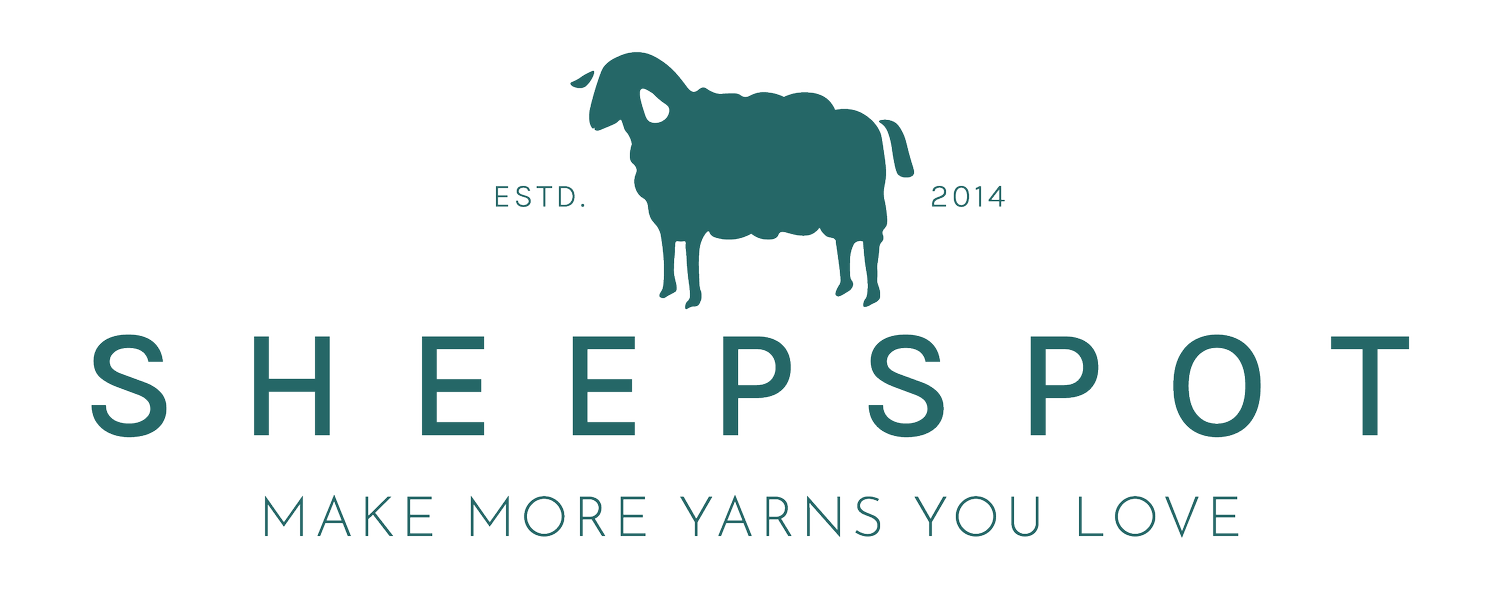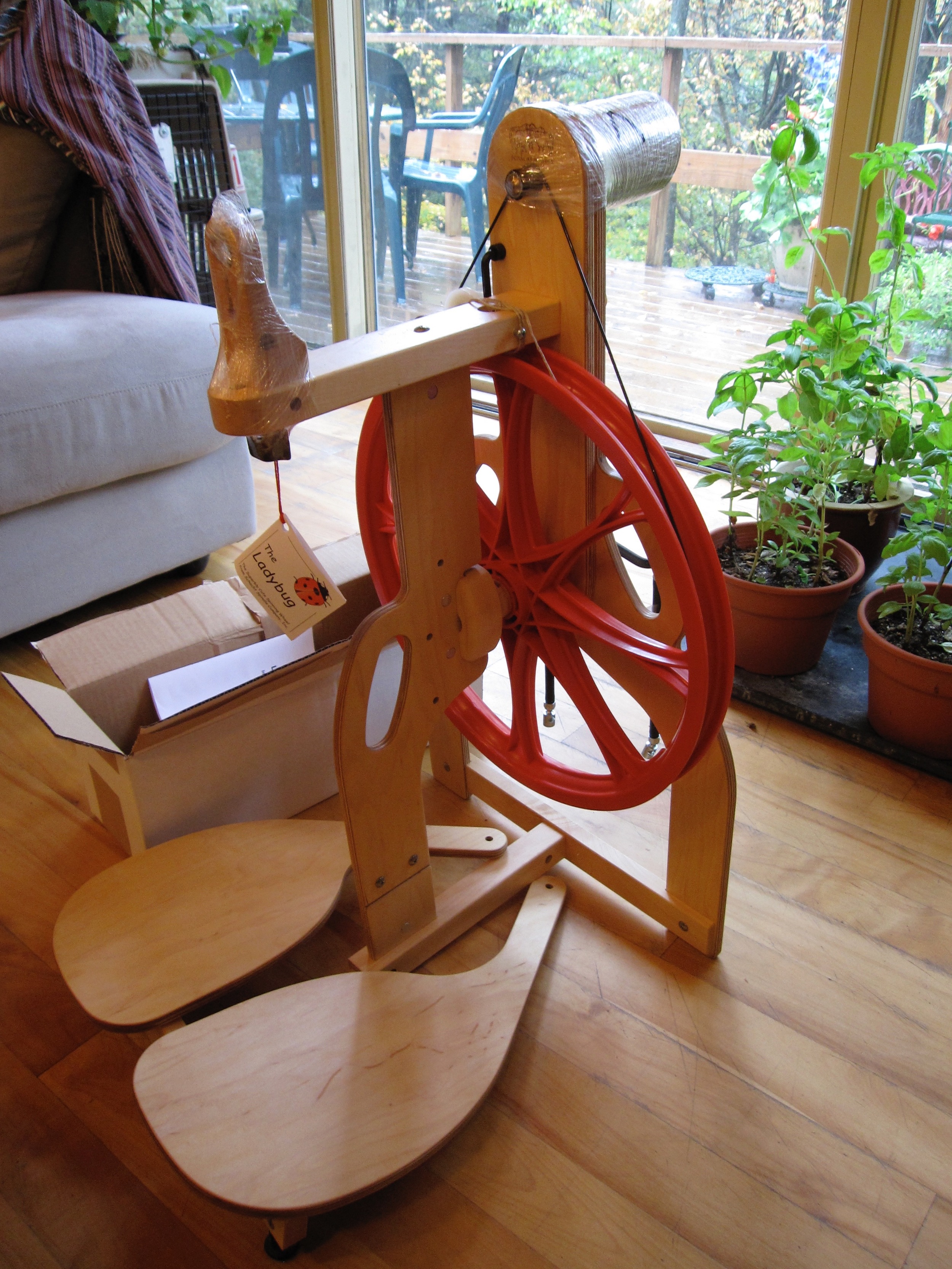My top 3 favorite beginner-friendly spinning wheels.
This is Esmé, a Schacht Ladybug, the day I bought her at the Vermont Sheep and Wool Festival in 2009. Note that I haven't even removed all the packaging or attached the treadles yet!
In this series, I'm sharing the basics of learning to spin: what you'll need, how to get started, and resources (all of which I've used myself). In case you missed it, part 1 (all about spindle spinning) is right here, part 2 (on the one step you need to do before you buy a wheel) is here, and part 3 (what type of wheel to buy) is here. Part 4, a dive into drive systems, is here on the blog, along with part 5, all about drive ratios.
OK. You’ve taken some lessons and you’re ready to make the plunge and buy a wheel. You know a bit about drive systems and drive ratios. Now it’s time for me to make some actual recommendations.
I'm going to suggest three wheels for you to consider in your quest for your wheel. All three are Scotch tension, or have Scotch tension as an option. All three come with a good range of drive ratios as part of the basic package, and in all three cases it’s possible to extend that range with additional purchases. So they are all wheels that can grow with you as you gain more experience and learn more about the kinds of yarns you most want to make. And they are all wheels I've spun on, and that come from companies with reputations for standing behind their products.
In no particular order:
The Schacht Ladybug. This was my own first wheel, and I still spin on her all the time (her name is Esmé). The Ladybug retails for $715 USD. It is a solidly-built double treadle wheel with a 16” drive wheel. At 12.5 lbs, it’s easy to move and transport. It can be set up in both double drive and Scotch tension, though in my experience it’s much happier in Scotch tension. It comes with 7:1, 9:1, 10.5:1, and 12.5:1 drive ratios out of the box; you can add additional ratios from 5:1 to 16:1 by buying additional whorls ($29 USD each). Included are drive bands, an orifice hook, and three bobbins. An attached lazy kate (to hold your bobbins when plying) is optional, as is an available bulky flyer, which can be useful for spinning textured yarns or for plying.
The Lendrum Original. I've always loved the look of this sleek, modern wheel that’s made right here in Ontario, but I'd never actually used one until I borrowed a single treadle model from a friend earlier this year. I think this is a great wheel—straightforward and responsive. It’s available with a single treadle for $560 USD, with a double treadle for $630, or you can get “the complete package,” which includes the double treadle model and lots of accessories that greatly enhance the wheel’s flexibility, for $790. It has a 19” drive wheel, and the basic model comes with a drive band, four bobbins, an orifice hook, and a lazy kate for plying. Standard drive ratios are 6:1, 8:1, and 10:1; with the “complete package” you’ll have a range from 5:1 to 17:1. It even folds up!
The Majacraft Pioneer. Majacraft wheels are built in New Zealand and the company has a solid record of innovation. The Pioneer is their entry-level wheel, but like the Ladybug and the Lendrum, it offers enough options to grow with a new spinner. It weighs 11 lbs, with a 12.6 inch drive wheel and double treadles. It comes with a drive band and three bobbins, and a range of drive ratios from 4.5:1 to 14.5:1. Majacraft offers optional whorls that will extend that range from 3.25:1 all the way up to 20:1. It lists at $750.
This list is by no means exhaustive; it reflects my experience and my taste. I haven’t spun on any of the Kromski wheels, for example, because I prefer a more modern look, but lots of people love them, and the company has a solid reputation. I have never personally spun on Louet’s Julia wheel, so don’t recommend it here, but it’s worth a look as well (it’s a Scotch tension wheel, unlike most of Louet’s lineup).
Choosing a wheel is a very personal process. In addition to thinking about price, aesthetics, what comes with the wheel, and what options are available as add-ons, don’t forget the most important thing: you need to be physically comfortable when spinning! Some wheels will just fit your body better than others. So consider this list a starting place, but spin on as many wheels as you can, and keep an open mind as you try them out.
Happy hunting! I'd love to know how your search turns out. And if you already have a wheel, tell me in the comments how you like it!
If you'd like information like this, along with sneak peeks at upcoming yarns and fibers, delivered right to your inbox each week, sign up here to get my newsletter! You can also opt-in to get my e-course on choosing and using breed-specific wools as a special thank you!

